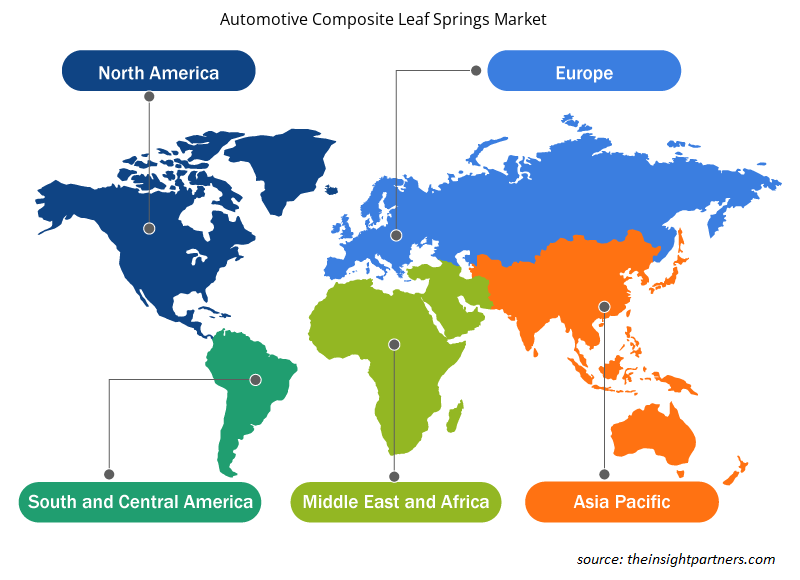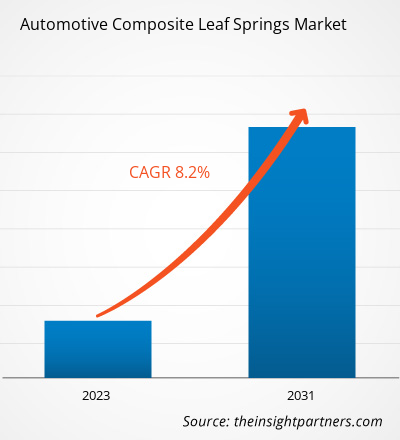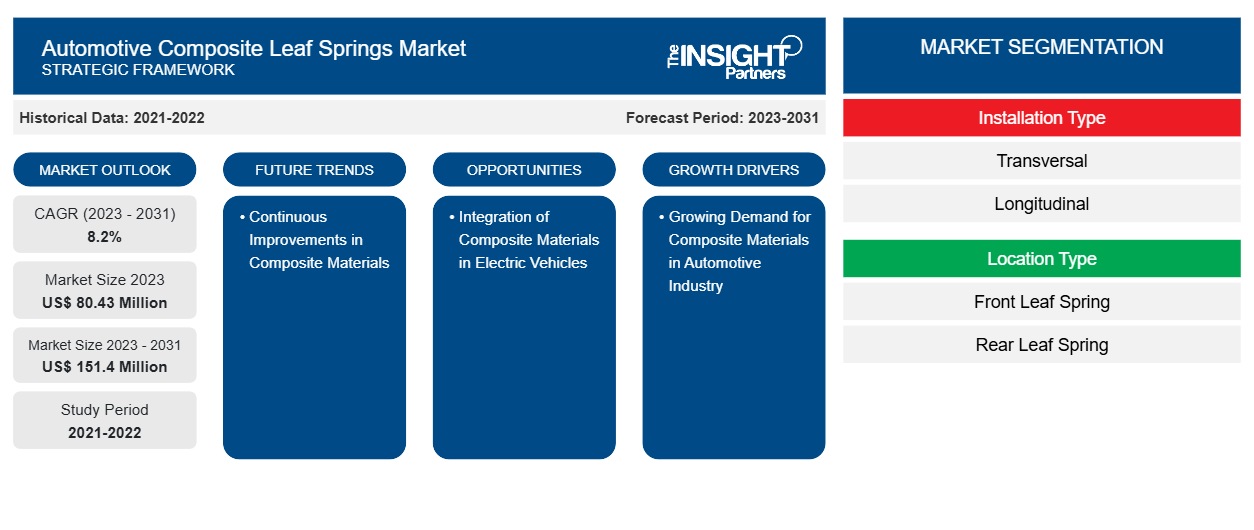자동차 복합 리프 스프링 시장 규모는 2023년 8,043만 달러에서 2031년까지 1억 5,140만 달러로 성장할 것으로 예상됩니다. 이 시장은 2023~2031년 동안 8.2%의 CAGR을 기록할 것으로 예상됩니다. 복합 소재의 지속적인 개선은 시장의 주요 추세로 남을 가능성이 높습니다.
자동차 복합 리프 스프링 시장 분석
자동차 부문의 구성품 제조에서 복합 소재에 대한 수요 증가는 분석 기간 동안 시장 성장을 촉진할 것으로 예상됩니다. 또한 전 세계적으로 SUV 및 경형 트럭과 같은 상용 및 승용차의 판매가 증가함에 따라 분석 기간 동안 자동차 복합 리프 스프링 시장 성장이 촉진될 것으로 예상됩니다. 또한 전기 자동차에서 복합 소재의 통합 및 채택 증가는 2023년부터 2031년까지 자동차 복합 리프 스프링 시장에서 운영하는 회사에 기회를 창출할 것으로 예상됩니다.
자동차 복합 리프 스프링 시장 개요
자동차 복합 리프 스프링 시장 생태계는 원자재 공급업체, 복합 리프 스프링 제조업체, OEM 및 최종 사용자로 구성됩니다. 원자재 공급업체는 자동차용 복합 리프 스프링을 제조하는 데 필요한 폴리머 매트릭스 복합재, 탄소 섬유 강화 플라스틱 및 에폭시 기반 복합재와 같은 복합 재료를 제공합니다. 자동차 산업의 확장으로 인해 TPI Composites와 같은 다양한 복합 재료 공급업체가 자동차 제조업체 및 자동차 부품 제조업체와 협력하게 되었습니다. 자동차 복합 리드 스프링 제조업체는 설계, 조립 및 생산과 같은 다양한 프로세스에 참여하여 원자재 복합 재료를 완제품으로 변환합니다. Muhr und Bender KG, KraussMaffei 및 SGL Carbon은 선도적인 자동차 복합 리프 스프링 제조업체 중 일부입니다. 이러한 회사는 BMW, Daimler, Volvo 및 Ford Motor Company와 같은 OEM에 고품질 복합 리프 스프링을 제공하며, 최종적으로 차량 생산 중에 제품을 설치합니다. 최종 사용자는 개인 차량 구매자부터 대규모 차량 운영자에 이르기까지 다양한 고객입니다.
귀하의 요구 사항에 맞게 이 보고서를 사용자 정의하세요
이 보고서의 일부 또는 국가 수준 분석, Excel 데이터 팩을 포함하여 모든 보고서에 대한 사용자 정의를 무료로 받을 수 있으며 신생 기업 및 대학을 위한 훌륭한 혜택과 할인 혜택을 이용할 수 있습니다.
-
이 보고서의 주요 시장 동향을 알아보세요.이 무료 샘플에는 시장 동향부터 추정 및 예측까지 다양한 데이터 분석이 포함됩니다.
자동차 복합 리프 스프링 시장 동인 및 기회
자동차 부문에서 복합소재에 대한 수요 증가로 시장이 호조
자동차 산업에서 복합 리프 스프링이 전통적인 리프 스프링보다 더 나은 점은 이를 채택하는 데 원동력이 되고 있습니다. 이 스프링은 강철 스프링보다 약 70% 더 가볍고, 더 얇고, 더 컴팩트하며, 내구성과 내하중성이 뛰어납니다. 또한 설계에 더 큰 유연성을 제공하고 뛰어난 주행 특성을 가지고 있습니다. 복합 리프 스프링은 또한 차량 에서 향상된 충격 흡수 성능을 제공하여 효과적인 하중 분산 솔루션에 중점을 둔 차량 제조업체에서 채택을 촉진합니다. 예를 들어, Hexcel은 픽업 트럭이 화물을 효과적으로 관리하는 데 도움이 되는 고급 복합 기반 리프 스프링을 개발했습니다. 이 회사가 제공하는 새로운 복합 리프 스프링은 픽업 트럭의 전체 중량을 차량당 약 45파운드 줄이는 데 도움이 됩니다. 자동차 애플리케이션에서 경량 복합 재료 사용에 대한 집중이 증가함에 따라 예측 기간 동안 시장 성장이 촉진될 것으로 예상됩니다. 또한 무게를 최소화하여 차량의 성능과 효율성을 개선하는 데 중점을 두면서 2023년에서 2031년까지 시장 성장이 촉진될 것으로 예상됩니다.
전기 자동차에 복합 소재 통합
전기 자동차는 소비자와 정부가 다양한 응용 분야에서 친환경 에너지 소비에 크게 기울고 있기 때문에 자동차 산업에서 떠오르는 추세입니다. 전기 자동차는 전체 자동차 시장에서 차지하는 비중은 작지만 연료 기반 자동차보다 높은 성장률을 경험하고 있습니다. 전기 자동차 제조업체 는 배터리로 차량 무게를 줄이기 위해 복합 재료를 사용하고 있습니다. 이를 통해 시간이 지남에 따라 부피가 커지는 배터리의 추가 무게를 보상하여 차량의 범위를 늘리는 데 도움이 됩니다. 2021년 9월에 공개된 새로운 전기 2인승 컨셉 스포츠카인 Aura는 차량 무게를 줄이고 제조 공정을 보다 지속 가능하게 만드는 데 도움이 되는 천연 섬유 복합 재료를 사용하여 개발되었습니다. 또한 인도의 연구원 그룹은 소음, 진동 및 거칠기를 줄이기 위한 전기 자동차용 복합 리프 스프링에 대한 연구를 발표했습니다. 따라서 복합 리프 스프링은 강철 계단 리프 스프링보다 무게가 40% 더 가볍고 응력 집중도가 76.39% 더 낮으며 변형이 50% 더 낮은 것이 특징입니다.
자동차 복합 리프 스프링 시장 보고서 세분화 분석
자동차 복합 리프 스프링 시장 분석 도출에 기여한 주요 세그먼트는 설치 유형, 위치 유형, 프로세스 유형 및 차량 유형입니다.
- 설치 유형에 따라 자동차 복합 리프 스프링 시장은 횡단형과 종단형으로 나뉩니다. 횡단형 세그먼트는 2023년에 가장 큰 시장 점유율을 차지했습니다.
- 위치 유형별로 시장은 전면 리프 스프링과 후면 리프 스프링으로 세분화됩니다. 후면 리프 스프링 세그먼트는 2023년에 시장에서 가장 큰 점유율을 차지했습니다.
- 공정 유형 측면에서 시장은 고압 수지 전사 성형 공정, 프리프레그 레이업 공정 및 기타로 나뉩니다. 고압 수지 전사 성형 세그먼트는 2023년에 시장에서 상당한 점유율을 차지했습니다.
- 차량 유형별로 시장은 승용차, 경상용차, 중형 및 대형 차량으로 세분화됩니다. 승용차 세그먼트는 2023년에 시장에서 가장 큰 점유율을 차지했습니다.
지역별 자동차 복합 리프 스프링 시장 점유율 분석
자동차 복합 리프 스프링 시장 보고서의 지리적 범위는 주로 북미, 아시아 태평양, 유럽, 중동 및 아프리카, 남미 및 중부 아메리카의 5개 지역으로 나뉩니다.
자동차 복합 리프 스프링 시장 보고서의 범위는 북미(미국, 캐나다, 멕시코), 유럽(독일, 프랑스, 이탈리아, 스페인, 영국, 유럽의 나머지 지역), 아시아 태평양(중국, 인도, 호주, 일본, 한국, 아시아 태평양의 나머지 지역), 중동 및 아프리카(남아프리카, 사우디 아라비아, UAE, 중동 및 아프리카의 나머지 지역), 남미(브라질, 아르헨티나, 남미의 나머지 지역)를 포함합니다. 수익 측면에서 유럽은 2023년 자동차 복합 리프 스프링 시장 점유율을 지배했습니다. 아시아 태평양은 글로벌 자동차 복합 리프 스프링 시장에서 두 번째로 큰 수익 기여자였으며 그 뒤를 북미가 이었습니다.
자동차 복합 리프 스프링 시장 지역 통찰력
Insight Partners의 분석가들은 예측 기간 동안 자동차 복합 리프 스프링 시장에 영향을 미치는 지역적 추세와 요인을 철저히 설명했습니다. 이 섹션에서는 북미, 유럽, 아시아 태평양, 중동 및 아프리카, 남미 및 중미의 자동차 복합 리프 스프링 시장 세그먼트와 지리에 대해서도 설명합니다.

- 자동차 복합 리프 스프링 시장에 대한 지역별 데이터 얻기
자동차 복합 리프 스프링 시장 보고서 범위
| 보고서 속성 | 세부 |
|---|---|
| 2023년 시장 규모 | 8,043만 달러 |
| 2031년까지 시장 규모 | 1억 5,140만 달러 |
| 글로벌 CAGR (2023-2031) | 8.2% |
| 역사적 데이터 | 2021-2022 |
| 예측 기간 | 2023-2031 |
| 다루는 세그먼트 |
설치 유형별
|
| 포함된 지역 및 국가 |
북아메리카
|
| 시장 선도 기업 및 주요 회사 프로필 |
|
자동차 복합 리프 스프링 시장 참여자 밀도: 비즈니스 역학에 미치는 영향 이해
자동차 복합 리프 스프링 시장 시장은 소비자 선호도의 변화, 기술 발전, 제품의 이점에 대한 인식 증가와 같은 요인으로 인해 최종 사용자 수요가 증가함에 따라 빠르게 성장하고 있습니다. 수요가 증가함에 따라 기업은 제품을 확장하고, 소비자의 요구를 충족하기 위해 혁신하고, 새로운 트렌드를 활용하여 시장 성장을 더욱 촉진하고 있습니다.
시장 참여자 밀도는 특정 시장이나 산업 내에서 운영되는 회사나 기업의 분포를 말합니다. 주어진 시장 공간에 얼마나 많은 경쟁자(시장 참여자)가 존재하는지 그 규모나 전체 시장 가치에 비해 나타냅니다.
자동차 복합 리프 스프링 시장에서 운영되는 주요 회사는 다음과 같습니다.
- 헨드릭슨 홀딩 유한회사
- 플렉스폼
- 크라우스마페이
- 무어 운트 벤더 KG
- 올군 셀릭 AS
- SGL 카본 SE
면책 조항 : 위에 나열된 회사는 어떤 특별한 순서에 따라 순위가 매겨지지 않았습니다.

- 자동차 복합 리프 스프링 시장 주요 업체 개요를 알아보세요
자동차 복합 리프 스프링 시장 뉴스 및 최근 개발
자동차 복합 리프 스프링 시장은 1차 및 2차 조사 후 정성적, 정량적 데이터를 수집하여 평가합니다. 여기에는 중요한 기업 간행물, 협회 데이터 및 데이터베이스가 포함됩니다. 자동차 복합 리프 스프링 시장의 몇 가지 개발 사항은 다음과 같습니다.
- Bcomp(지속 가능한 경량 기업)는 새로운 볼보 EX30에 ampliTex라는 천연 섬유 복합 기술을 적용한다고 발표했습니다. (출처: Bcomp, 보도자료, 2023년 6월)
- Hexion, Inc.는 Rassini와 협력했습니다. 이 협력은 새로운 Ford F-150 모델에서 복합 리프 스프링 적용을 위해 EPIKOTE 에폭시 수지 시스템을 사용하는 것을 목표로 했습니다. (출처: Hexion, Inc., 보도자료, 2021년 6월)
자동차 복합 리프 스프링 시장 보고서 범위 및 제공물
“자동차 복합 리프 스프링 시장 규모 및 예측(2021-2031)” 보고서는 아래 영역을 포괄하는 시장에 대한 자세한 분석을 제공합니다.
- 범위에 포함된 모든 주요 시장 세그먼트에 대한 글로벌, 지역 및 국가 수준의 자동차 복합 리프 스프링 시장 규모 및 예측
- 자동차 복합 리프 스프링 시장 동향 및 운전자, 제지장치 및 주요 기회와 같은 시장 역학
- 자세한 PEST 및 SWOT 분석
- 주요 시장 동향, 글로벌 및 지역 프레임워크, 주요 업체, 규정 및 최근 시장 개발 사항을 포괄하는 자동차 복합 리프 스프링 시장 분석
- 시장 집중도, 히트맵 분석, 유명 업체 및 자동차 복합 리프 스프링 시장의 최근 개발 사항을 다루는 산업 환경 및 경쟁 분석
- 자세한 회사 프로필
- 과거 분석(2년), 기준 연도, CAGR을 포함한 예측(7년)
- PEST 및 SWOT 분석
- 시장 규모 가치/거래량 - 글로벌, 지역, 국가
- 산업 및 경쟁 환경
- Excel 데이터세트
최근 보고서
사용 후기
구매 이유
- 정보에 기반한 의사 결정
- 시장 역학 이해
- 경쟁 분석
- 고객 인사이트
- 시장 예측
- 위험 완화
- 전략 기획
- 투자 타당성 분석
- 신흥 시장 파악
- 마케팅 전략 강화
- 운영 효율성 향상
- 규제 동향에 발맞춰 대응























 무료 샘플 받기 - 자동차용 복합 리프 스프링 시장
무료 샘플 받기 - 자동차용 복합 리프 스프링 시장